Apollo 11
Monday, 20th July 2009 by RobK
Unless you've been living on the, er, Moon, you can hardly have failed to notice that today1 marks the 40th anniversary of the historic landing of the Apollo 11 mission – during which, Neil Armstrong became the first human being to ever set foot on the Moon.
Apollo 11 was launched on a Saturn V rocket at 9:32 AM on July 16, 1969 from Launch Complex 39-A at Cape Canaveral in Florida. The same pad is also used for Space Shuttle launches, including the recent launch of Endeavour. Apparently, when a fully fuelled rocket is on the pad, the minimum safe distance for people is 5km! However, on the day that the Street View car visited it did get close enough to get a distant view of the launch tower rising above the swampland.
At the nearby Kennedy Space Center we can see a replica Space Shuttle, as well as the Rocket Garden (a display of Redstone, Titan and Atlas rockets) and the Space Mirror (or at least its shadow) - a 13-metre high memorial to those who have lost their lives in space.
Over at the Johnson Space Center in Houston, the Saturn V rocket that we looked at four years ago is now under cover unfortunately. Still, at least we can gaze down on the very building in which the brainy Mission Control folks kept things running smoothly.
Of course Houston wasn't the only place keeping tabs on the astronauts. As anyone who has seen the movie The Dish will know, at the time Neil Armstrong stepped onto the moon, it was on the "wrong" side of the Earth; which meant the historic TV signal was actually relayed via Australia.
The best pictures came from the Parkes Observatory in New South Wales, but the signal was also picked up at Honeysuckle Creek Tracking Station near Canberra. Sadly, Parkes is only visible in low-resolution (although you can glimpse the dish through the trees on Street View), and Honeysuckle Creek, while in high-res, was closed in 1981 and subsequently demolished.
And what of the first man on the moon? Neil Armstrong was born in the small town of Wapakoneta, Ohio, and during his school years his family lived here on West Benton Street. The town is obviously proud of its famous son: in the vicinity we can find roads named Neil Armstrong Drive, Lunar Drive, Gemini Drive, Saturn Drive and Apollo Drive - the latter four located near the Armstrong Air & Space Museum, where exhibits apparently include the Gemini VIII spacecraft, Apollo 11 artefacts, a moon rock, and "multimedia presentations of the sights and sounds of space"2.
Finally, let's have a look at the moon itself! Google Moon has come on a bit since it was unveiled on the landing's 36th anniversary, meaning you can even look around in Street View-esque panorama mode at the landing sites. And, in case you haven't heard, NASA's Lunar Reconnaissance Orbiter recently managed to photograph 5 out of the 6 Apollo landing sites, with sufficient detail that you can make out the lunar module descent stages, and even, in one case, the trails of footprints left by the astronauts! Google has some way to go to match that sort of resolution, but as it happens, they are holding a special Google Earth news conference later today...
There's more to see on our previous coverage of Cape Canaveral and the Kennedy Space Center, you can watch a real-time recreation of the landing at We Choose The Moon and join in with various celebratory events at NASA's site.
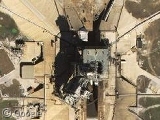
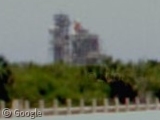
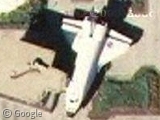
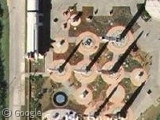
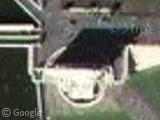
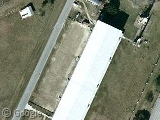
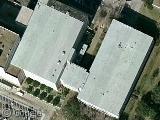
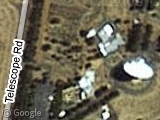
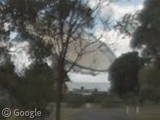
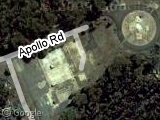
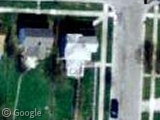
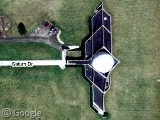
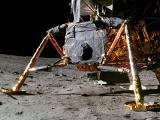
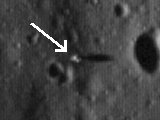
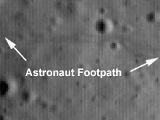
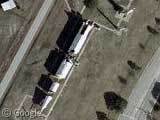


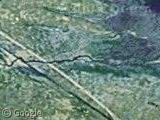
Lets not forget the contribution made by the Lovell Telescope at Jodrell Bank in ‘leafy’ Cheshire to the space race.
https://www.googlesightseeing.com/maps?p=&c=&t=h&hl=en&ll=53.236609,-2.309103&z=17
http://en.wikipedia.org/wiki/Jodrell_Bank_Observatory
Here is another (tenuous?) claim by a northern observatory that it was pivotal in the lunar landings!
http://news.bbc.co.uk/local/manchester/hi/people_and_places/history/newsid_8155000/8155355.stm
And here it is all its glory!
View Placemark
The other place you can see a Saturn V laid out is Space Camp in Huntsville, AL:
View Placemark
As expected, as of now, Google Earth has an option to select fully realised 3D moon as your “planet” of choice when using Google Earth:
Full details and instructions here: http://www.gearthblog.com/blog/archives/2009/07/look_at_the_moon_in_google_earth_-.html
There’s another lunar module visible on Google Maps (and Street View) – it’s in the grounds of the Franklin Institute in Philadelphia. Apparently it was restored from one that was partially built at the time Apollo was cancelled.
View Placemark
Honeysuckle Creek Dish is still operational at Tidbinbilla Deep Space Tracking Station ( as Deep Station 46) 20km SW of Canberra. 20km north of old Honeysuckle Creek Site.
Hi this is raj